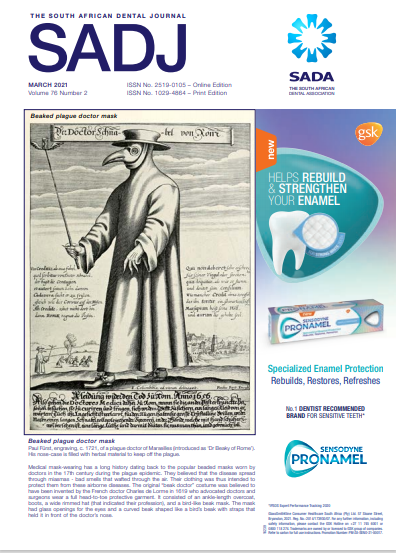Examining the effect of exposure time on the erosive potential of sour candy
DOI:
https://doi.org/10.17159/2519-0105/2021/v76no2a2Keywords:
sour candy, erosion, tooth enamel, acidsAbstract
This study aimed to evaluate the erosive potential of sour candy at a different time of exposure within a laboratory-based setting. Fifty human anterior tooth samples were randomly assigned into three groups, namely: sour candy, regular candy A, and deionized water (n=15). Each tooth sample was exposed to a solution containing the sample groups at different time intervals. Vickers hardness tester was used to measure the surface hardness pre- and postexposure. The mean surface hardness value measured was compared using a paired sample test (α =.05). Raman spectroscopy was used to study the change in the enamel structure in all sample groups. A significant difference in the surface hardness value was measured pre and post-exposure in all the sample groups (P<0.01). The samples exposed to sour candy had the highest tooth surface loss. In terms of the time of exposure, it was found that prolonged exposure had a significant effect on the surface hardness (P<0.01). The Raman intensity change confirmed that samples exposed to sour candy, after 2 hrs of exposure, had the highest loss of structural integrity. The study conclude that sour candies are very erosive and its impact enhances with time.
Downloads
References
Buzalaf MAR, Hannas AR, Kato MT. Saliva and dental erosion. J Appl Oral Sci. 2012; 20(5): 493-502.
Lazzaris M, Farias MMAG, Araújo SM, Schmitt BHE, Silveira EG. Erosive potential of commercially available candies. Pesqui Bras Odontopediatria Clin Integr. 2015; 15(1): 7-12.
Farias MMAG, Silveira EGd, Schmitt BHE, Araújo SMd, Baier IBA. Prevalência da erosão dental em crianças e adolescentes brasileiros. Salusvita. 2013; 32(2).
Murakami C, Oliveira LB, Sheiham A, Corrêa MSNP, Haddad AE, Bönecker M. Risk indicators for erosive tooth wear in Brazilian preschool children. Caries Res. 2011; 45(2): 121-9.
Stacey N, van Walbeek C, Maboshe M, Tugendhaft A, Hofman K. Energy drink consumption and marketing in South Africa. Prev. Med. 2017; 105:S32-S6.
Pinto SC, Bandeca MC, Silva CN, Cavassim R, Borges AH, Sampaio JE. Erosive potential of energy drinks on the dentine surface. BMC Res. Notes. 2013; 6(1): 67.
Zero D, Lussi A. Dental erosion. Monogr Oral Sci. 2006; 20: 100-5.
Stewart KF, Fairchild RM, Jones RJ, Hunter L, Harris C, Morgan MZ. Children's understandings and motivations surrounding novelty sweets: a qualitative study. Int. J. Paediatr. Dent. 2013; 23(6): 424-34.
Brand H, Gambon D, Paap A, Bulthuis M, Veerman E, Amerongen AN. The erosive potential of lollipops. Int. Dent J. 2009; 59(6): 358-62.
Nahas Pires Correa MS, Nahás Pires Corrêa F, Nahas Pires Correa JP, Murakami C, Mendes FM. Prevalence and associated factors of dental erosion in children and adolescents of a private dental practice. International J Paediatr Dent. 2011; 21(6): 451-8.
Aljawad A. Dental public health implications of novelty sweets consumption in children: Cardiff University. 2016.
Aljawad A, Morgan MZ, Fairchild R, Rees J. Investigation of the erosive potential of sour novelty sweets. Br. Dent. J. 2017; 222(8): 613.
Wagoner SN, Marshall TA, Qian F, Wefel JS. In vitro enamel erosion associated with commercially available original-flavorand sour versions of candies. J Am Dent Assoc. 2009; 140(7): 906-13.
Lussi A, von Salis-Marincek M, Ganss C, Hellwig E, Cheaib Z, Jaeggi T. Clinical study monitoring the pH on tooth surfaces in patients with and without erosion. Caries Res. 2012; 46(6): 507-12.
Turssi CP, Silva CS, Bridi EC, Amaral F, Franca F, Basting RT. Kinetics of salivary pH after acidic beverage intake by patients undergoing orthodontic treatment. Gen. Dent. 2015; 63(3): 26-30.
dos Reis Oliveira PR, Amaral FLB, França FMG, Basting RT, Turssi CP. Sour Gummy Candies and their Effect on Salivary pH kinetics. Pesqui Bras Odontopediatria Clin Integr. 2018; 18(1): 3866.
El-Marakby AM. Surface hardness assessment of tooth Substrates and Different Esthetic Restorative Materials after Immersion in Different Acidic media. Int J Dent & Oral Heal. 2018; 4(11): 178-83.
West N, Hughes J, Addy M. The effect of pH on the erosion of dentine and enamel by dietary acids in vitro. J Oral Rehabil. 2001; 28(9): 860-4.
Barbour ME, Lussi A. Erosion in relation to nutrition and the environment. Erosive Tooth Wear. 25: Karger Publishers. 2014; 143-54.
Farias MMAG, de Oliveira MML, Schmitt BHE, da Silveira EG, de Araújo SM. Erosive potential of sugar-free hard candies dissolved in water and artificial saliva. Braz J Oral Sci. 2016; 15(1): 75-8.
Mudumba VL, Muppa R, Srinivas N, Kumar DM. Evaluation and comparison of changes in microhardness of primary and permanent enamel on exposure to acidic center-filled chewing gum: an in vitro study. Int J Clin Pediatr Dent. 2014; 7(1): 24.
Bolan M, Ferreira M, Vieira R. Erosive effects of acidic center-filled chewing gum on primary and permanent enamel. J Indian Soc Pedod Prev Dent. 2008; 26(4): 149.
Onwubu SC, Mdluli PS, Singh S, Nyembe S, Thakur R. Anin situ evaluation of the protective effect of nano eggshell/titanium dioxide against erosive acids. Int J Dent. 2018.
Kim I-H, Son JS, Min BK, Kim YK, Kim K-H, Kwon T-Y. A simple, sensitive and non-destructive technique for characterizing bovine dental enamel erosion: attenuated total reflection Fourier transform infrared spectroscopy. Int J Oral Sci. 2016; 8(1): 54-60.
Kozisek F. Health risks from drinking demineralised water. Nutr in Drinking Water, 2005; 1(1): 148-163.
Onwubu SC, Mdluli PS, Singh S. Evaluating the buffering and acid-resistant properties of eggshell–titanium dioxide composite against erosive acids. J Appl Biomater Funct Mater. 2019; 17(1): 1-7
Downloads
Published
Issue
Section
License
Copyright (c) 2021 Lesley S Naidoo, Stanley C Onwubu, Nelisha Murugan, Shenuka Singh

This work is licensed under a Creative Commons Attribution-NonCommercial 4.0 International License.





.png)